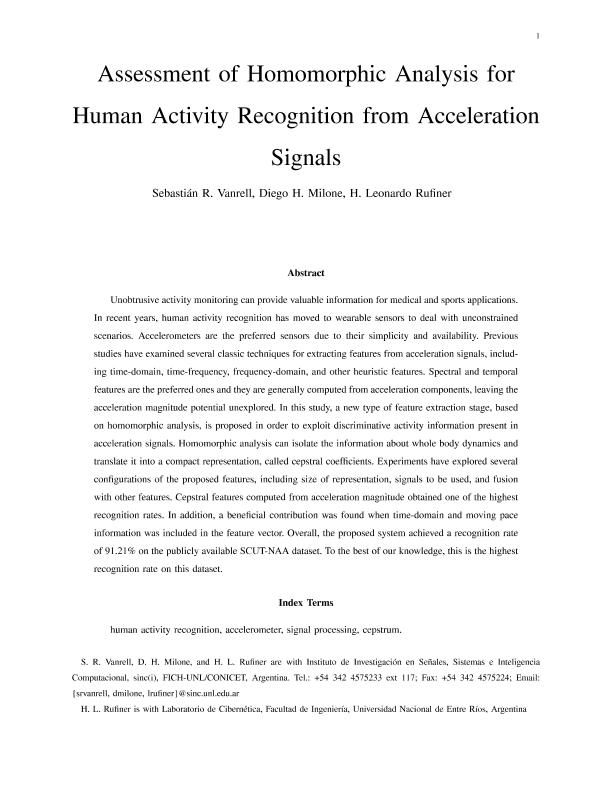Mostrar el registro sencillo del ítem
dc.contributor.author
Vanrell, Sebastián Rodrigo

dc.contributor.author
Milone, Diego Humberto

dc.contributor.author
Rufiner, Hugo Leonardo

dc.date.available
2018-06-06T19:54:43Z
dc.date.issued
2017-07
dc.identifier.citation
Vanrell, Sebastián Rodrigo; Milone, Diego Humberto; Rufiner, Hugo Leonardo; Assessment of Homomorphic Analysis for Human Activity Recognition from Acceleration Signals; Institute of Electrical and Electronics Engineers; IEEE Journal of Biomedical and Health Informatics; 7-2017; 1-1
dc.identifier.issn
2168-2194
dc.identifier.uri
http://hdl.handle.net/11336/47576
dc.description.abstract
Unobtrusive activity monitoring can provide valuable information for medical and sports applications. In recent years, human activity recognition has moved to wearable sensors to deal with unconstrained scenarios. Accelerometers are the preferred sensors due to their simplicity and availability. Previous studies have examined several classic techniques for extracting features from acceleration signals, including time-domain, time-frequency, frequency-domain, and other heuristic features. Spectral and temporal features are the preferred ones and they are generally computed from acceleration components, leaving the acceleration magnitude potential unexplored. In this study, a new type of feature extraction stage, based on homomorphic analysis, is proposed in order to exploit discriminative activity information present in acceleration signals. Homomorphic analysis can isolate the information about whole body dynamics and translate it into a compact representation, called cepstral coefficients. Experiments have explored several configurations of the proposed features, including size of representation, signals to be used, and fusion with other features. Cepstral features computed from acceleration magnitude obtained one of the highest recognition rates. In addition, a beneficial contribution was found when time-domain and moving pace information was included in the feature vector. Overall, the proposed system achieved a recognition rate of 91.21% on the publicly available SCUT-NAA dataset. To the best of our knowledge, this is the highest recognition rate on this dataset.
dc.format
application/pdf
dc.language.iso
eng
dc.publisher
Institute of Electrical and Electronics Engineers

dc.rights
info:eu-repo/semantics/openAccess
dc.rights.uri
https://creativecommons.org/licenses/by-nc-sa/2.5/ar/
dc.subject
Human Activity Recognition
dc.subject
Accelerometer
dc.subject
Signal Processing
dc.subject
Cepstrum
dc.subject.classification
Ciencias de la Computación

dc.subject.classification
Ciencias de la Computación e Información

dc.subject.classification
CIENCIAS NATURALES Y EXACTAS

dc.title
Assessment of Homomorphic Analysis for Human Activity Recognition from Acceleration Signals
dc.type
info:eu-repo/semantics/article
dc.type
info:ar-repo/semantics/artículo
dc.type
info:eu-repo/semantics/publishedVersion
dc.date.updated
2018-05-31T18:18:54Z
dc.identifier.eissn
2168-2208
dc.journal.pagination
1-1
dc.journal.pais
Estados Unidos

dc.journal.ciudad
Nueva York
dc.description.fil
Fil: Vanrell, Sebastián Rodrigo. Consejo Nacional de Investigaciones Científicas y Técnicas. Centro Científico Tecnológico Conicet - Santa Fe. Instituto de Investigación en Señales, Sistemas e Inteligencia Computacional. Universidad Nacional del Litoral. Facultad de Ingeniería y Ciencias Hídricas. Instituto de Investigación en Señales, Sistemas e Inteligencia Computacional; Argentina
dc.description.fil
Fil: Milone, Diego Humberto. Consejo Nacional de Investigaciones Científicas y Técnicas. Centro Científico Tecnológico Conicet - Santa Fe. Instituto de Investigación en Señales, Sistemas e Inteligencia Computacional. Universidad Nacional del Litoral. Facultad de Ingeniería y Ciencias Hídricas. Instituto de Investigación en Señales, Sistemas e Inteligencia Computacional; Argentina
dc.description.fil
Fil: Rufiner, Hugo Leonardo. Consejo Nacional de Investigaciones Científicas y Técnicas. Centro Científico Tecnológico Conicet - Santa Fe. Instituto de Investigación en Señales, Sistemas e Inteligencia Computacional. Universidad Nacional del Litoral. Facultad de Ingeniería y Ciencias Hídricas. Instituto de Investigación en Señales, Sistemas e Inteligencia Computacional; Argentina
dc.journal.title
IEEE Journal of Biomedical and Health Informatics
dc.relation.alternativeid
info:eu-repo/semantics/altIdentifier/url/http://ieeexplore.ieee.org/document/7967663/
dc.relation.alternativeid
info:eu-repo/semantics/altIdentifier/doi/http://dx.doi.org/10.1109/JBHI.2017.2722870
Archivos asociados
